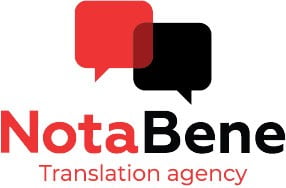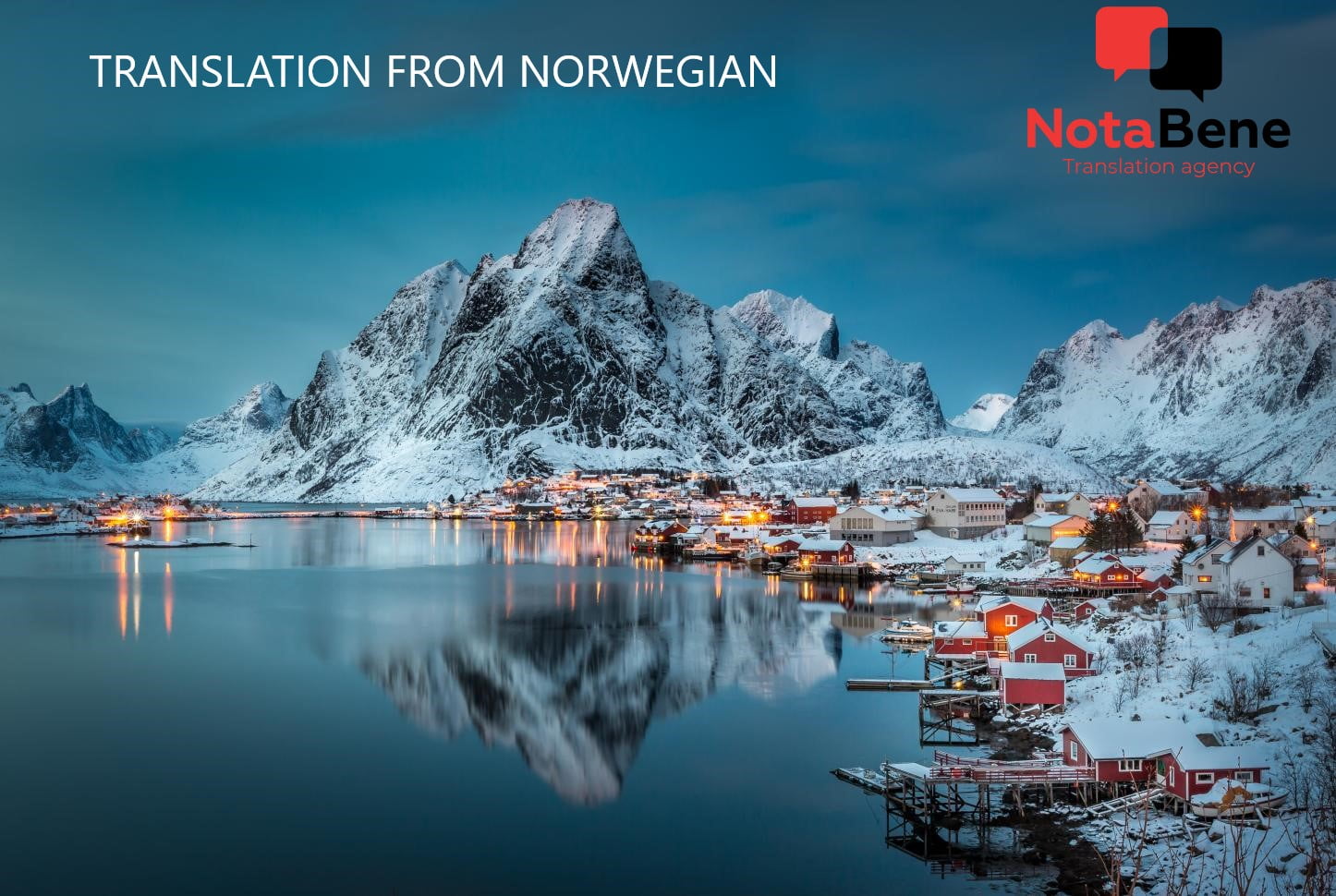Order translation from Norwegian or into Norwegian at NotaBene Agency in Warsaw and Gdansk!
NotaBene Translation Agency is an experienced supplier of translation from Norwegian into Polish and vice versa for any documents or texts.
What types of texts does NotaBene Translation Agency work with?
– Technical translation from Norwegian — we translate any texts in electronics, aviation and shipbuilding, agriculture, industry, oil and chemistry, etc. For this purpose, we pick translators who understand the specific nature of a given industry.
– IT translation from Norwegian for the localization of applications, games, software and websites.
– Medical translation from Norwegian — books, manuals, articles in specialized printed and online publications, clinical records, correspondence with medical institutions, transcriptions and translations of test results, instructions for medicines and many other types of texts. This kind of translation requires flawless knowledge of medical terminology and focus on detail to rule out ambiguity, because the result can affect the health or life of many people.
– Legal translation from Norwegian: statutes, registration deeds, articles of incorporation, contracts, powers of attorney, court records and many other similar documents.
– Financial translation from Norwegian includes the translation of balance sheets, tax returns, payment invoices, waybills, tender documents, etc.
– Literary or fiction translation from Norwegian of fiction, marketing and advertising materials. Unlike the previous types of translation, in this case there is more room for a translator’s creativity, because there is no need for “word for word” translation. The most important thing is that the translated material produces the same impact as the original, while an excellent translation may even make it better.
Please note that the translation mentioned is certified by an agency seal only. If you need sworn translation, kindly notify your manager in advance. Sworn translation is possible only for certain languages.
How to have a translation from Norwegian into English, Polish, Russian, Belarusian or Ukrainian?
First of all, you need to order it. To do so, send your source text and specify your requirements for the translation from Norwegian. A customer service specialist at the Nota Bene Translation Agency will prepare a ToR based on the specific features of the order. If the project involves more than one job, a unique glossary is created to ensure the consistency and proper use of terminology.
An entire team of several professionals normally works on a translation from Norwegian: a translator, proofreader, editor, quality controller, layout designer and manager who will be available during working hours. In order to rule out human errors, the translation agency uses modern services to check punctuation, idioms, numerical expressions, and formulas. The material is also reviewed by the chief editor.
Confidentiality of translated data is ensured by a special NDA, whenever a customer wishes to have one. Documents can be delivered to any country.
We very rarely apply additional fees for “urgency” or “specialized subjects”, so you can be sure that the price will not rise when the project is delivered. It is true that in rare cases, such as “we need to have it yesterday” instances, and when a customer is willing to pay a higher rate for the team to work outside normal working hours, at night or on weekends, the fee might be increased, but this is always negotiated with the customer in advance.
Interesting facts about the Norwegian language
Norwegian is by no means the most widely spoken languages in the world. Nevertheless, it is spoken by approximately 4.5 million people. It is a language used exclusively in Norway, and there is considerable variety in its vocabulary and grammar. Norwegian has a peculiar beauty, indeed, like the country where it is spoken.
1. Norwegian belongs to the Germanic group, the Scandinavian subgroup. It comes from Old Scandinavian, which was once one of the most widely spoken languages of its time. It is believed that Norwegian took shape during the arrival of Christianity in Scandinavia (around 1030), along with which came the Latin alphabet. Before that the Scandinavians used runic script.
2. The Norwegian language is very similar to Swedish and Danish. Not surprisingly, because Norway was for a long time a part of Denmark, and then was entirely dependent on Sweden. For a time, Danish was even the official written language of the country, used by the elite of society. Norway was not fully independent until 1905. Since then, the Norwegians have given much efforts to maintain their language identity. The Icelandic and Faroese languages are also considered close to Norwegian.
3. Interestingly enough, the result is that Norwegian is sort of in the middle between Swedish and Danish. The Swedes and Danes can understand Norwegian, but they can barely understand each other.
4. Officially there are two official forms of Norwegian: bokmål (lit. “book speech”) and nynorsk (lit. “new Norwegian”). Both were legislated relatively recently, in 1929. At that, Bumol is more widespread; about 90% of urban dwellers speak it and it is more widely used in mass media. This dialect is mostly studied by foreigners. Nynorsk, on the other hand, is more wide-spread in rural areas.
5. As is often the case with European languages, Norwegian has a lot of dialects. Their exact number is not even known. It is not unusual for villagers in one village to speak a dialect which is difficult to understand for people from another village, if only in a nearby location. However, over time and with the development of communication the difference between the dialects is gradually blurred.
6. Over the years the difference between Bukmolle and Nynorsk has also been blurred, it is thought that the two dialects will gradually merge into one language. There were several attempts to do this in the early twentieth century, but they were fruitless because people did not want to change anything in their speech, and because of the inaccessibility of some parts of Norway.
7. In 1917 a formidable grammatical ‘revision’ of the Norwegian language was undertaken. In particular, a decision was made to “Norwegianise” words of foreign origin. As a result, the English words ending in ‘-tion’ were replaced with ‘-sjon’ (nation – nasjon). Generally there were many rearrangements and changes made at that time, many of them based on political reasons.
8. If you’re intimidated by complicated grammar, perhaps you should take up learning Norwegian. For example, the verb “er” (“to be”), which is typical for many European languages, has the same form for all pronouns: jeg er, du er, vi er… The negation is formed by adding the particle “likke” after the verb, regardless of its tense. For example, jeg er (‘I am’) jeg er likke (I am not). To make a question, simply put the verb before the pronoun: er jeg? (“am I?”). The same rules apply for the verb ‘ha’ (‘to have’): jeg har, du har, vi har…
9. The very first dictionary of the Norwegian language was published in 1634. It was a book called Termini legales norvegici by a Norwegian nobleman called Jens Bjelkes. The dictionary was intended for Danish statesmen who went to serve in Norway.
10. One of the distinguishing features of Norwegian is the letter “å”, also found in other Scandinavian dialects. However, it has appeared in the language rather recently, in 1917, when it was used instead of the double “aa”. The letter å comes from Swedish, where it has been used since as early as the 16th century. However, this letter has not yet won a definitive victory, you can still meet words with “aa”.
11. There is no definite article in Norwegian. In order to point to an object, the speaker simply inserts the definite article at the end of the word. For example, en katt (cat) becomes katten. There are three indefinite articles in the language: en for masculine, ei for feminine and et for neuter.
We have been in business for over 20 years and during that time we have learned to work well. Trust us with your translation from Norwegian and get a great result at a reasonable price!








